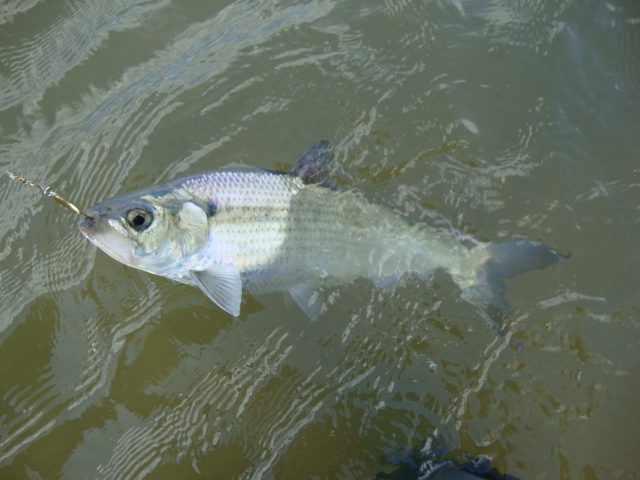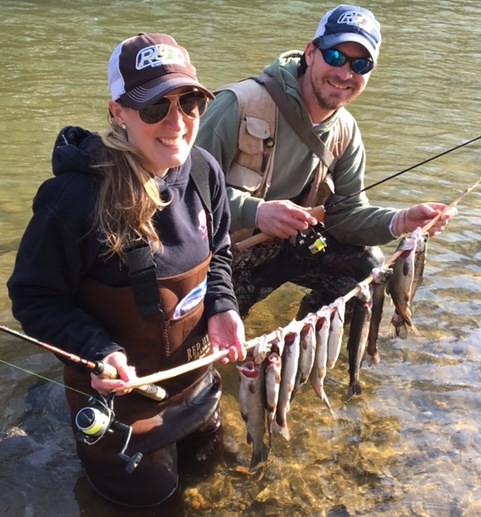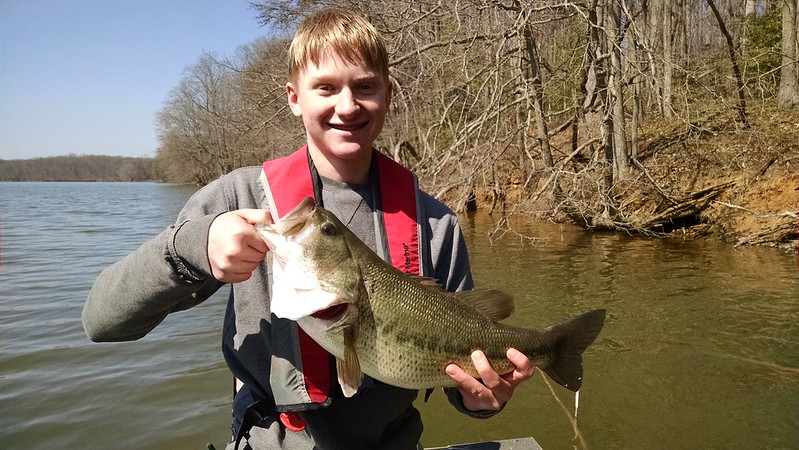Via MD DNR:
By: Keith Lockwood
Mother Nature has reminded us this week to not be too hasty about packing away warm coats. Cold weather has moved in and has decided to stick around for a while. Day time temperatures are not too bad as long as the wind lies down but oh those chilly nights!
Although recent cold weather will knock back spawning activities of striped bass, hickory shad and American shad around the Susquehanna Flats and lower Susquehanna River; the fish are there and will present some catch and release opportunities this week. Before this cold snap, water temperatures at the Susquehanna Flats were about 53°. Large pre-spawn striped bass are being caught and released around the flats on soft plastic jigs and spoons. The shad are in the lower Susquehanna and a few have been caught near the dam lately. The flows out of the dam have been minimal lately and combined with very strong northwesterly winds, tides have been very low in the bay and lower Susquehanna River for the past few days. The Fisheries Service shad restoration team has begun collecting hickory and American shad brood stock in the lower Susquehanna River and other shad spawning rivers with their electro-fishing boat last week. The crew attempted to launch their boat yesterday morning at the Lapidum boat ramp and this was the scene they were presented with; a very low tide and exposed river bottom.

Lapidum ramp, photo courtesy of Chuck Stence
The adult fish are stripped of their eggs and once they are fertilized, the eggs are hatched and raised up to fry size at the Manning Hatchery (Maryland Fisheries Service), Horn Point (University of Maryland) and Caulk Point (NRG) for restoring spawning populations of hickory and American shad in the Chesapeake Bay's tidal rivers and creeks. To learn more about shad restoration efforts in Maryland the Fisheries Service has a very informative website explaining the program's efforts.
The weather forecast for the next week shows the possibility of a couple of warmer days but with chilly night time temperatures the water temperatures in Deer Creek may stay depressed below the minimum spawning temperature of 54° which will trigger the hickory shad to begin their ascent into Deer Creek. Anyone who wishes to fish at the mouth of Deer Creek for hickory shad should note that the park service has removed the steps near the parking area on the south side of the creek that lead down to the water's edge due to their unsafe condition.

Hickory shad, photo courtesy of Ken Kopro
The Potomac River below the Chain Bridge (Route 123) is another good place to catch and release hickory and American Shad and shad were caught there over the weekend. There is a popular boat livery called Fletchers where one can rent a row boat to row out to catch blue catfish or practice catch and release for hickory and American shad. Maryland fishermen are reminded that they will need to purchase a District of Columbia fishing license when fishing over the Maryland line. There are other shad fishing locations on Maryland's tidal rivers and these sites can be viewed on the shad fishing map site.
Water temperatures in the Chesapeake generally will remain at about 50° this week and most likely will be stable until another warming trend occurs. Spawning populations of striped bass are now in all of the major spawning rivers and last weekend noticeable spawning began to occur in the Nanticoke, Patuxent, Potomac and Choptank Rivers. Anyone near these spawning reaches cannot mistake the smell of fish in the air which is due to fish oils and spawn on the surface of the water. Laughing gulls can be seen dipping at the surface looking for bits of fat during this time in the current and tide lines. Most often the spawning takes off during an ebbing tide and splashing fish can be seen at the surface. The cold nights that are predicted for the next week are not a good situation for striped bass eggs and newly hatched larvae and many will have a hard time surviving the drop in surface water temperatures. Fortunately there are more striped bass waiting in the rivers and bay for optimum spawning water temperatures of 60° to 64.5°.
Fishermen are reminded that however tempting it might be, to not attempt to practice catch and release for striped bass in the closed spawning reaches. Violations carry stiff fines and license suspensions for recreational fishermen. There are areas such as the Susquehanna Flats, areas in the main stem of the bay and the Potomac River where catch and release is allowed. We have striped bass recreational fishing maps online showing the different striped bass areas and dates as described in regulations.
White perch fishing has been good in most of Maryland's tidal rivers as the perch descend down the rivers after spawning. Generally they can be found in some of the deeper holes in the middle and lower sections of the tidal rivers. Shad darts tipped with pieces of bloodworm or minnow or a simple bottom rig baited with the same will work well. Channel catfish will also be part of the mix when fishing close to the bottom.
Trout fishing in the many trout management waters spread across the state is in full swing this week. Water conditions are good in most areas and fisheries crews are busy stocking trout. The latest stocking can be viewed on the trout stocking website or fisheries email subscribers can be notified by email. Jesse Lowers and his sister enjoyed a fun opening day on the Gunpowder where they got to fish together and go home with a limit of trout each.

Trout, photo courtesy of Grant Soukup
The upper Potomac River is reported to be running clear with water temperatures at about 60°. Fishing for smallmouth bass has been particularly good due to warmer water temperatures. The smaller bass are very active now and provide plenty of action for anglers casting tubes around current breaks, underwater ledges and rocks. The larger smallmouth bass are also part of the mix as are walleyes.
Deep Creek Lake is slowly warming up and smallmouth bass and largemouth bass are active along rocky points, deep grass edges and largemouth are holding in shallower waters. Yellow perch fishing has been good for those drifting minnows under slip bobbers and walleye can be part of the mix in some areas. Northern pike and chain pickerel are holding in the shallower coves along emerging grass edges. Crappie can be found holding near the Glendale and Route 219 Bridges.
Largemouth bass are beginning to show pre-spawn behavior in many of Maryland's ponds, lakes and tidal rivers. Last week's warm temperatures have driven water temperatures up to the point where male largemouth bass are exploring the shallow areas for spawning bed sites. The girls tend to be holding in transition areas in slightly deeper water but will venture into shallower areas midday for a little warmth. In the tidal rivers this movement is often triggered by a flood tide. Any kind of sunken structure in these transition areas is a good place to target with grubs and similar soft plastics or crankbaits. Adam Falter was fishing on a central Maryland reservoir with his dad when he caught and released this beautiful largemouth bass.

Bass, photo courtesy of Greg Falter
Northern snakeheads have moved into shallower waters and they too are in a pre-spawn mode of behavior. They will tend to gravitate towards any structure they can find, especially emerging grass, spatterdock or lily pads. They will hit most any type of lure that comes across their path but noisy surface lures such as chatterbaits or buzzbaits can draw their attention from afar. The best opportunities for snakeheads are in the tidal creeks of the upper tidal Potomac but there are populations of snakeheads spread throughout the Wicomico River, the Nanticoke and the backwaters of Dorchester County.
Fishing for blue catfish in the tidal Potomac River is a good option for anyone wishing to enjoy a lot of fishing action and a good tussle along with some fine eating. Cut bait from menhaden, gizzard shad, bluegills or white perch make excellent bait; just be sure to bring a big cooler.
Crappie continue to be found near sunken brush, fallen treetops and bridge or dock piers. They tend to be holding in deeper water and placing a minnow or small jig about 2 or 3 feet below a slip bobber is a good way to catch them. Most lakes and ponds have populations of crappie as do the tidal rivers. Bridge piers are another good place to find schools of crappie congregating. The bridge piers of Dulaney Valley Road over Loch Raven Reservoir or Deer Park Road over Liberty Reservoir, which has a fishing walkway alongside the roadway bridge, are a few examples.
Coastal fishing near Ocean City is beginning to become more interesting as warmer water temperatures begin to kick some of the traditional spring fisheries in gear. Surf casters are catching a few striped bass in the surf and every once in a while one will exceed the 28" minimum. There are a lot of spiny dogfish in the surf and they delight in chewing up baits and keep dozing fishermen on their toes. A couple of black drum have been reported to be caught in the surf recently.
The boat yards are seeing activity in the rows of boats in winter storage as captains and crew work to get their vessels ready for the coming season. Memories of the spring run of Atlantic or "Boston" mackerel tend to come to life amongst the old timers and discussions of "what was once". The spring runs of Atlantic mackerel were the big incentive to get one's boat in the water to enjoy those April runs off the coast. Memories of "Christmas Tree Rigs", being bitten off by thresher sharks, tasty smoked mackerel in the refrigerator and fresh mackerel for dinner do not fade away easily.
Tautog are increasing in numbers in and around the Ocean City Inlet every day. The South Jetty has been a great place to fish with success for anyone who has a boat in the water. The bulkheads from 2nd to 4th Streets and Route 50 Bridge piers has been good places to fish for shore bound anglers. Pieces of crab and sand fleas have been good baits to use and the bottom of an ebbing tide brings the warmest water from the bay and tickles the tog into biting.
There is some fun striped bass fishing in the back bay areas near the Route 90 Bridge and the Verrazano Bridge. Most are enjoying good success by casting bucktails and soft plastic jigs across the current and walking the dog as the jig moves down current. Most of the striped bass are undersized but there are a few over 28". Rumors abound concerning the first flounder but nothing official yet.
Outside the inlet boats have been fishing the inshore wrecks and reefs for tautog. Catches have been fair to good depending on the mood the fish are in and the success of the captain getting on the fish. Pieces of green crab or white leggers have been the most common baits.
Boom...Morgan
No comments:
Post a Comment